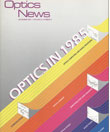
December, 1985 Issue
- Coherent Time-Domain Far-Infrared Spectroscopy; Direct Laser Generation of 27-FSEC Ultrashort Optical Pulses
- Shaping of Ultrashort Optical Pulses; Ultrashort Pulse-Pumped Dye Lasers
- Extremely Broadband Lasers and Detectors; Ultrashort Pulses from Semiconductor Lasers
- Ultrashort Pulses from Semiconductor Lasers
- LEDS as High-Bit-Rate Sources for Single-Mode Fiber
- High Speed Optical Heterodyne Transmission in Single-Mode Fiber
- Array of Picosecond GAAS Optical Gates
- High-Temperature Color Center Applications
- Photon-Gated Spectral Hole-Burning; Shorter Optical Pulses by Pulse Compression
- Browse all Issues
Feature Articles
A new approach to far-infrared spectroscopy uses nonlinear optics and femtosecond optical pulses to generate and measure extremely short electromagnetic transients whose frequency spectra span a large portion of the entire far-infrared spectral range.
by D. H. Auston and K. F. CheungShaping of Ultrashort Optical Pulses; Ultrashort Pulse-Pumped Dye Lasers
A technique has been developed which allows arbitrary shaping of ultrashort optical pulses.
by J. P. Heritage, R. N. Thurston, and A. M. WeinerExtremely Broadband Lasers and Detectors; Ultrashort Pulses from Semiconductor Lasers
Recently, the bandwidths of long-wavelength optical sources and detectors have more than doubled, opening up new applications in optical transmission systems.
by J. E. Bowers, C. A. BurrusUltrashort Pulses from Semiconductor Lasers
Using ultrashort light pulses for communications systems will require suitable commercial lasers, rather than the cumbersome laboratory models available to date. AT&T Bell Laboratories has recently developed a mode-locking technique for generating just such pulses in commercial laser diodes.
by D. J. Eilenberger, Y. Silberberg, P. W. Smith, Bell Communications Research; and D. A. B. MillerLEDS as High-Bit-Rate Sources for Single-Mode Fiber
Future broadband optical communications applications, such as feeder systems to homes and businesses, favor single-mode fibers because of their enormous potential for upgrading as services and technology progress. These applications require the reliability and cost advantages offered at present only by light-emitting diodes (LEDs).
by P. W. Shumate, M. B. Romeiser, and N. K. CheungHigh Speed Optical Heterodyne Transmission in Single-Mode Fiber
With recent progress in lightwave technology, optical heterodyne and homodyne detection methods, commonly referred to as coherent communications, are becoming increasingly viable. The techniques are important to future lightwave communications systems because they offer substantially higher receiver sensitivity, as well as the ability to tune to a large number of channels with small frequency separation.
by R. S. Vodhanel, J. L. Gimlett, R. D. Standley, and N. K. CheungArray of Picosecond GAAS Optical Gates
Current efforts to reduce the switching times of optical bistable devices, and to fabricate large device arrays, are laying the groundwork for future integration of these devices into a working computer or signal processor.
by N. Peyghambarian and H. M. GibbsHigh-Temperature Color Center Applications
In phase-conjugate optics, new applications of color centers have been demonstrated. Research on color centers may yield improved, solid state versions of liquid devices—tunable lasers, Q switches, and mode-lockers—which incorporate crystals. These solid systems would be less complicated than liquid ones, and well suited for communications and remote sensing applications.
by S. C. RandPhoton-Gated Spectral Hole-Burning; Shorter Optical Pulses by Pulse Compression
Recently, two-color photon-gated persistent spectral hole-burning (PHB) was observed for the first time in an inorganic material (BaClF:Sm2+) and an organic material (carbazole in boric acid glass). By demonstrating that nondestructive reading of spectral holes is possible, a new dimension for optical storage of information has been opened up.
by W. E. Moerner, R. M. Macfarlane and R. M. Shelby

![Manual probe system with needles for test of semiconductor on silicon wafer. [A. Morozov / Getty]](https://opnmedia.blob.core.windows.net/$web/opn/media/images/articles/2025/1125/departments/202511-cover-web.jpg?ext=.jpg)
![Researcher Clara Saraceno in the lab. [Image by Carsten Behler Photography]](https://opnmedia.blob.core.windows.net/$web/opn/media/images/articles/2025/1025/departments/202510-cover-web.jpg?ext=.jpg)
